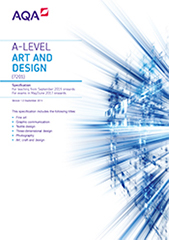3.4 Fine art
Students should be introduced to a variety of experiences that explore a range of fine art media, processes and techniques. They should be made aware of both traditional and new media.
Students should explore the use of drawing for different purposes, using a variety of methods and media on a variety of scales. Students may use sketchbooks/workbooks/journals to underpin their work where appropriate.
Students should explore relevant images, artefacts and resources relating to a range of art, craft and design, from the past and from recent times, including European and non-European examples. This should be integral to the investigating and making processes. Students' responses to these examples must be shown through practical and critical activities that demonstrate their understanding of different styles, genres and traditions.
Students should be aware of the four assessment objectives to be demonstrated in the context of the content and skills presented. They should be aware of the importance of process as well as product.
Areas of study
Students are required to work in one or more area(s) of Fine art, such as those listed below. They may explore overlapping areas and combinations of areas:
- drawing and painting
- mixed-media, including collage and assemblage
- sculpture
- ceramics
- installation
- printmaking (relief, intaglio, screen processes and lithography)
- moving image and photography.
Skills and techniques
Students will be expected to demonstrate skills, as defined in Overarching knowledge, understanding and skills, in the context of their chosen area(s) of Fine art. In addition, students will be required to demonstrate skills in all of the following:
- appreciation of different approaches to recording images, such as observation, analysis, expression and imagination
- awareness of intended audience or purpose for their chosen area(s) of fine art
- understanding of the conventions of figurative/representational and abstract/non-representational imagery or genres
- appreciation of different ways of working, such as, using underpainting, glazing, wash and impasto; modelling, carving, casting, constructing, assembling and welding; etching, engraving, drypoint, mono printing, lino printing, screen printing, photo silkscreen and lithography
- understanding of pictorial space, composition, rhythm, scale and structure
- appreciation of colour, line, tone, texture, shape and form.
Knowledge and understanding
Students must show knowledge and understanding of:
- how ideas, feelings and meanings can be conveyed and interpreted in images and artefacts in the chosen area(s) of study within fine art
- historical and contemporary developments and different styles and genres
- how images and artefacts relate to social, environmental, cultural and/or ethical contexts, and to the time and place in which they were created
- continuity and change in different styles, genres and traditions relevant to fine art
- a working vocabulary and specialist terminology that is relevant to their chosen area(s) of fine art.
